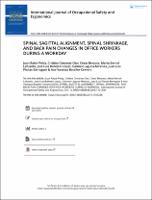Por favor, use este identificador para citar o enlazar este ítem:
https://repositorio.usj.es/handle/123456789/1111
Registro completo de metadatos
| Campo DC | Valor | Lengua/Idioma |
|---|---|---|
| dc.contributor.author | Rabal-Pelay, Juan | - |
| dc.contributor.author | Cimarras-Otal, Cristina | - |
| dc.contributor.author | Berzosa Sánchez, César | - |
| dc.contributor.author | Bernal-Lafuente, Marta | - |
| dc.contributor.author | Ballestín-López, José Luis | - |
| dc.contributor.author | Laguna-Miranda, Carmen | - |
| dc.contributor.author | Planas-Barraguer, Juan Luis | - |
| dc.contributor.author | Bataller-Cervero, Ana Vanessa | - |
| dc.date.accessioned | 2024-02-08T08:40:46Z | - |
| dc.date.available | 2024-02-08T08:40:46Z | - |
| dc.date.issued | 2020-02-19 | - |
| dc.identifier.citation | Juan Rabal-Pelay, Cristina Cimarras-Otal, Mónica Macia-Calvo, Carmen Laguna-Miranda & Ana Vanessa Bataller-Cervero. (2021) Use of a Spinal Traction Device during Work Shift in Assembly Line Workers. International Journal of Environmental Research and Public Health 18:14, pages 7708 | en_US |
| dc.identifier.issn | 1080-3548 | en_US |
| dc.identifier.uri | https://repositorio.usj.es/handle/123456789/1111 | - |
| dc.description.abstract | Purpose. Prolonged sitting is a risk factor for the appearance of lower back pain during work. The aim of this study was to observe changes in spinal sagittal alignment, height and the perception of back pain in office workers during a workday. Materials and methods. Forty-one office workers (20 women) were enrolled into a cross-sectional study. Height, sitting height and degrees of thoracic kyphosis and lumbar lordosis as well as perceived neck pain, lower back pain and upper back pain were determined, before and after an 8-h workday. Results. At the end of the day, workers had a significant decrease (p = 0.000) in height and sitting height, and upper back pain increased significantly (p = 0.023). In men, spinal shrinkage correlated with neck pain (r = 0.410, p = 0.027), and lumbar lordosis degrees in women correlated negatively with upper back pain at the end of the day (r = −0.440, p = 0.012). Conclusions. Spinal shrinkage equally affects men and women who perform the same work. There are no changes in spinal sagittal alignment throughout the workday in office workers. Office workers show significantly increased pain in the upper back at the end of the day. | en_US |
| dc.format.extent | 20 p. | en_US |
| dc.format.mimetype | application/pdf | en_US |
| dc.language.iso | eng | en_US |
| dc.publisher | Taylor & Francis & Central Institute for Labour Protection – National Research Institute (CIOP-PIB) | en_US |
| dc.relation | This work was supported by Operative Program ERDF Aragon 2014-2020, 'Building Europe from Aragon', Research Group ValorA. | en_US |
| dc.rights | Attribution-NonCommercial-NoDerivatives 4.0 Internacional | * |
| dc.rights.uri | http://creativecommons.org/licenses/by-nc-nd/4.0/ | * |
| dc.subject | Occupational Back Pain | en_US |
| dc.subject | Ergonomics | en_US |
| dc.subject | Spine | en_US |
| dc.subject | Seated Work | en_US |
| dc.subject | Sitting height | en_US |
| dc.title | Spinal sagittal alignment, spinal shrinkage and back pain changes in office workers during a workday (Versión aceptada) | en_US |
| dc.type | info:eu-repo/semantics/acceptedVersion | en_US |
| dc.identifier.doi | 10.1080/10803548.2019.1701238 | en_US |
| dc.rights.accessrights | info:eu-repo/semantics/openAccess | en_US |
| Aparece en las colecciones: | Artículos de revistas | |
Ficheros en este ítem:
| Fichero | Descripción | Tamaño | Formato | |
|---|---|---|---|---|
| SPINAL SAGITTAL ALIGNMENT (versión aceptada).pdf | 430,45 kB | Adobe PDF |  Visualizar/Abrir |
Este ítem está sujeto a una licencia Creative Commons Licencia Creative Commons

